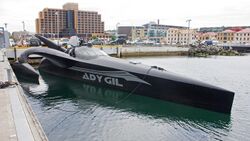Physics:Wave-piercing hull
From HandWiki
Short description: Hull with fine bow with reduced reserve buoyancy

MY Ady Gil in 2009
A wave-piercing boat hull has a very fine bow, with reduced buoyancy in the forward portions. When a wave is encountered, the lack of buoyancy means the hull pierces through the water rather than riding over the top, resulting in a smoother ride than traditional designs, and in diminished mechanical stress on the vessel. It also reduces a boat's wave-making resistance.
Design theory calls for very long thin hulls, so in practice most are multi-hulls such as catamarans and trimarans.
The main current usage areas are passenger ferries[1] and naval ships.[2]
See also
- Engineering:Axe bow – Wave-piercing type of a ship's bow
- Physics:Bulbous bow – Protruding bulb at the front of a ship
- HMAS Jervis Bay (AKR 45)
- HSV-2 Swift – Hybrid catamaran
- Engineering:Inverted bow – Bow whose farthest forward point is not at the top
- Norwegian Cruise Line Engineering:Project Leonardo-Class Cruise Ships
- Engineering:Tumblehome – Design element of ships and automobiles hull form
- Engineering:Type 22 missile boat – Ship class in the Chinese People's Liberation Army Navy
- USS Independence (LCS-2): high-speed trimaran warship
- Engineering:Zumwalt-class destroyer – Stealth missile destroyer class of the US Navy
References
- ↑ Tarantola, Andrew (29 June 2013). "Monster Machines: The World's Fastest Boat Is Basically An Aquatic Concorde Jet". Gizmodo. https://www.gizmodo.com.au/2013/06/monster-machines-the-worlds-fastest-boat-is-basically-an-aquatic-concorde-jet/. Retrieved 7 June 2018.
- ↑ "Rolls-Royce wins first Environship order". MarineLog. https://www.marinelog.com/index.php?option=com_k2&view=item&id=1415:rolls-royce-wins-first-environship-order&Itemid=257. Retrieved 7 June 2018.
 |


